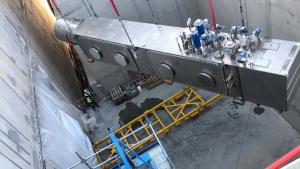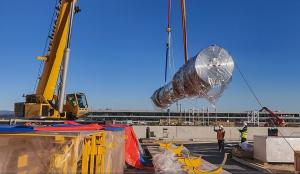Building the feeders, segment by segment
Through an opening in the Tritium Building just large enough to admit the 11-metre-long components, two magnet feeder segments were introduced this month into the lower basement of the Tokamak Complex. From there, they were transported approximately 180 metres on rollers to their reserved positions around the Tokamak.
Like spokes around the hub of a wheel, 21 feeders will be installed in the lower basement level (B2) of the Tokamak Building—all directed toward the magnet systems at machine centre; another 10 will be installed above the machine at L3 level. (See the illustrations in this article.) Measuring 30 to 50 metres in length and composed of three distinct segments, feeders are complex components that distribute and recover cryogenic fluids at different temperatures and connect the magnets to their power supplies. Key subcomponents that are housed inside the magnet feeders include high temperature superconducting current leads, busbars, piping for cryogenic fluids, and the cables for diagnostics signals—all carefully insulated by an actively cooled thermal shield and a vacuum duct.
Coil termination boxes are the feeder segments located farthest from the machine core, outside of the bioshield. Cryostat feedthroughs pass through the concrete bioshield and cryostat and into the vacuum environment. And in-cryostat feeders connect directly to the superconducting coils.
Over five years (2019 to 2023) the Chinese Domestic Agency will deliver the fully instrumented segments and equipment required for 31 feeders—approximately 1,600 tonnes of material and 100 large components. The teams at ITER will install and assemble the feeders, and realize 300 magnet feeder joints (more on that tricky operation here).
For now, though, the assembly teams are positioning the elements received from China around the Tokamak pit. Five have been lowered into the Tokamak Complex including two this month: the cryostat feedthrough for poloidal field coil #4 (PF4, installation complete); the cryostat feedthrough for toroidal field coils #12 and #13 (TF12-13, installation complete); the coil terminal box serving TF12-13 (ongoing); the coil termination box for PF4 (this month, ongoing); and a cryostat feedthrough for the structure cooling feeder (STR3), which will supply supercritical helium to the case cooling circuits and the inter-coil-structure cooling circuits of the toroidal field coils, the central solenoid structures, and the correction coils (this month, ongoing).
The latest operations were carried out by the TAC1 assembly contractor CNPE under the careful supervision of Tingzhi Zhou, Chen-Yu Gung, and Giobatta Lanfranco from the In-Cryostat, Cryostat Thermal Shield, Auxiliaries Section. The first activity on feeder joints is planned for this summer after the completion of special process qualification by the contractor.



